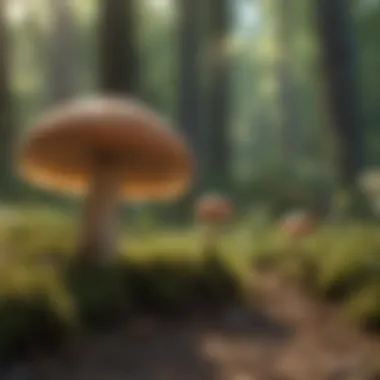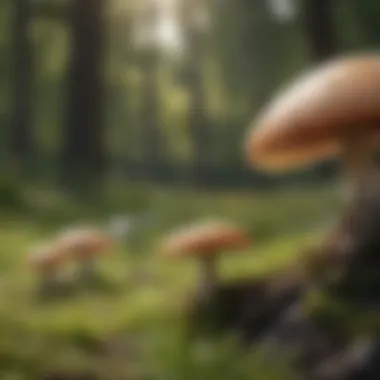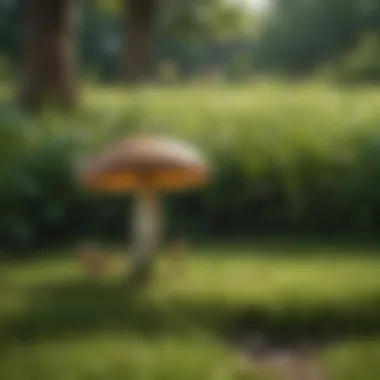Effective Strategies for Removing Lawn Mushrooms


Intro
Mushrooms can be quite the uninvited guests in a well-manicured lawn. While some homeowners find these fungi to add a touch of mystique to their outdoor space, many others see them as a sign of an underlying issue that needs addressing. The presence of mushrooms often indicates high moisture levels, decay, or even poor soil conditions. For those looking to maintain a pristine grass patch, understanding how to effectively remove mushrooms is crucial.
This article aims to delve into the various methods available for tackling mushroom growth in residential lawns. We will explore natural and chemical eradication strategies, while also considering the ecological factors contributing to their proliferation. By integrating effective practices, homeowners can reclaim their outdoor spaces, ensuring a healthy and vibrant lawn free from unwanted fungi.
Understanding the Nature of Lawn Mushrooms
Mushrooms popping up in your yard can turn a well-maintained lawn into a scene straight out of a horror movie. The first step in addressing this nuisance is to understand what you’re dealing with. Knowledge about lawn mushrooms not only helps you manage your outdoor space but also fosters a healthier ecosystem. Understanding these fungi is critical because it allows homeowners to identify whether the mushrooms are harmful to pets, plants, or humans.
The Biology of Mushrooms
Mushrooms are the fruiting bodies of fungi, which means they are just the visible part of a much larger organism known as mycelium. Mycelium lives underground and comprises a network of thread-like structures called hyphae. This underground life can stretch for miles, creating an extensive support system for the mushrooms above. When conditions are right—think moist soil and organic material—the mycelium sends up mushrooms, often in a hurry. The biology of mushrooms is fascinating; they reproduce by releasing spores, just like plants with seeds, which means they can spread quite rapidly, leading to more mushrooms in your lawn.
Common Types of Lawn Mushrooms
There’s a wide variety of mushrooms that can be found in residential lawns. Some common types might include:
- Fairy Rings: These mushrooms form circular patterns in the grass and are often seen as a sign of good luck or fairies by some.
- Puffballs: Typically white and round, puffballs can release spores when they are stepped on. This usually makes kids giggle, but they can also spread mushrooms all over.
- Chicken of the Woods: A distinct and brightly colored bracket mushroom, this one is edible, but not all mushrooms are fit for your plate.
Identifying these mushrooms requires keen observation. Size, shape, and color can vary immensely based on species, which can either bolster or hinder pest control efforts. Just make sure you’re not mistaking an edible variety for something toxic.
Mushrooms and Their Role in the Ecosystem
Don’t be too quick to pull out every mushroom you see. Believe it or not, mushrooms play essential roles in the environment. They break down decaying plant matter, improving soil health. This natural recycling process enriches the soil and helps maintain a balanced ecosystem. Mushrooms can also form symbiotic relationships with plants, assisting in nutrient absorption. For instance, mycorrhizal fungi help trees and plants access more moisture and nutrients, which can enhance their growth and overall health.
"Mushrooms may seem like a nuisance, but they are nature’s clean-up crew!"
Understanding these roles can reshape one’s perspective on these fungi. Rather than viewing them solely as invaders, consider them as components of a much bigger environmental puzzle. Carefully managing their presence, rather than outright elimination, can lead to a more sustainable lawn.
Overall, a comprehensive understanding of lawn mushrooms helps inform your approach to lawn care. By recognizing the biology, the varieties, and their ecosystem contributions, homeowners are better equipped to take meaningful action when fungi invade their outdoor spaces.
Identifying the Conditions for Mushroom Growth
Understanding the conditions that foster the growth of mushrooms is crucial for effectively managing and eliminating these fungi from your lawn. Mushrooms thrive under specific environmental factors, and gaining insight into these conditions helps homeowners take preventative measures as well as informed actions when dealing with mushroom infestations.
By making small adjustments in your lawn care practices and being aware of these factors, you can significantly reduce the prevalence of mushrooms and foster a healthier outdoor space.
Soil Moisture Levels
Keeping an eye on soil moisture is more than just basic lawn care, it can really mean the difference between a thriving lawn and an unwelcome crop of mushrooms. Ground that’s overly wet creates a perfect breeding ground for fungi, including mushrooms. If your lawn feels like a sponge when you step on it, you’re living in prime mushroom real estate.
To combat this, drainage is key. Here are a few strategies you might find effective:
- Aeration: Use a lawn aerator to break up compacted soil, which allows water to penetrate better.
- Proper Watering: Water your lawn at midday when evaporation is at its peak, reducing soggy conditions.
- Planting Choices: Some grass species are better at draining water than others. Choosing the right type can make all the difference.
Keeping your soil moist enough to sustain growth—but not so much that it invites mushrooms—is a balancing act that takes keen attention.


Nutrient-Rich Environments
Much like humans, mushrooms enjoy a feast. Nutrient-rich soils can promote mushroom growth, particularly if the soil is loaded with organic material like decomposing leaves or wood. While a healthy lawn often benefits from nutrient density, excess buildup can spur mushroom growth faster than a rabbit on a carrot farm.
A few considerations to make your soil less inviting to mushrooms include:
- Regular Cleanup: Make sure to rake up leaves and debris which can contribute to excess nutrients and moisture.
- Compost Wisely: Ensure compost piles are managed properly and not left in the open lawn where they can spread spores.
- Balanced Fertilization: Avoid over-fertilizing. Instead, a soil test can guide you in creating a balanced nutrient profile for your lawn.
By maintaining an appropriate level of nutrients, you can curb the enthusiasm of mushrooms before they ever break through the surface.
Shade and Sunlight Exposure
Finally, let’s talk sunshine. Mushrooms prefer darker spots, where sunlight struggles to penetrate. Think of shady corners in your garden, beneath trees, or any place where water and nutrients stack up without enough light to dry things out.
You can manage light exposure in several ways:
- Trimming Plants: Regularly trim any overgrown plants or branches that create shade can help let the sunshine in where it’s needed.
- Open Spaces: Create openings in your garden layout that allow sunlight to reach usually dark spots.
- Choosing Grass Wisely: If shade is unavoidable, consider growing shade-tolerant grass varieties that thrive better in low-light conditions.
Light levels are not just a factor for mushrooms; they play a significant role in the overall health of your lawn. In addition to lessening mushroom growth, more sunlight can promote vigorous grass growth.
The balance among soil moisture, nutrient levels, and exposure to sunlight is delicate. Being proactive by identifying and adjusting these factors is essential for creating an environment less hospitable to mushrooms while simultaneously ensuring a robust lawn.
Implementing Natural Removal Techniques
Mushrooms popping up in your lawn aren't just a nuisance; they hint at underlying issues in your soil or moisture levels. Tackling this head-on with natural removal methods can save you time, effort, and the potential harm of chemical solutions. With a blend of practicality and environmental consciousness, these techniques allow you to engage with your lawn in a way that promotes overall health and sustainability. Here's how you can go about it.
Manual Removal Methods
When the mushrooms start appearing like an unwelcome guest, manual removal can be your first line of defense. It's straightforward and often effective, especially for a small infestation.
Gathering and Disposal Techniques
Gathering and disposal is akin to picking apples from a tree. It's a physical process that requires little more than your hands and a bag. You start by identifying the mushrooms—some have a penchant for reappearing, so ensure you get every last one. The key characteristic here is that you’re not just pulling them out hastily; you should be gentle, to avoid tearing the mycelium underneath.
Why is this a popular choice? Because it is simple and cost-effective. Not only does it help remove visible mushrooms, but it also allows you to inspect your lawn for excess moisture areas that may be breeding these fungi. Just remember to dispose of the collected mushrooms properly—bin them or compost them, but don’t leave them lying around.
Unique feature? Manual removal encourages you to engage with your environment. As you venture into your yard, you’ll notice more than just mushrooms—you might spot areas needing attention.
Advantages? Well, it’s the most immediate response and less harmful to the ecosystem compared to chemical solutions. However, it’s worth mentioning that this method may require regular effort, especially where mushrooms like to return.
The Implications of Removing Mycelium
Now, if you tread deeper, we reach the mycelium. When you're removing mushrooms, you may unwittingly detach some of the mycelium, which is the underground network of fungal threads that nourishes mushrooms. The implications can be quite significant. Sometimes, it’s beneficial to leave it be, as the mycelium can help break down organic matter and maintain soil health.
The key characteristic? Its unique ability to support lawn health is remarkable. When properly nurtured, mycelium can assist in nutrient transfer, helping grass thrive.
Is there a downside? The downside is that removing mycelium can disrupt these benefits. If you overzealously remove everything, your lawn might end up needing more fertilizers in the future, leading you into a cycle of dependency.


In sum, being mindful about what gets removed can help maintain the balance in your lawn’s ecosystem.
Improving Drainage and Soil Aeration
Improving drainage and soil aeration is not merely a process but a necessary shift for long-term lawn health. Mushrooms often flourish in damp, compacted soil. By aerating the ground, you increase oxygen flow and drainage, making it less hospitable for fungi. It’s not rocket science—you can use a garden fork or a specialized aerator. Just poke holes in the ground every few inches. Better air and water circulation can work wonders, transforming your lawn into a more resilient landscape.
Adjusting Lawn Care Practices
Lastly, adjusting your lawn care practices might just be the trick you need. Overwatering can create a paradise for mushrooms and fungi. Make a note to cycle your watering schedule based on weather conditions, giving your lawn a chance to breathe.
Additionally, consider the type of mulch or compost you apply. Some might be overly rich, giving rise to fungal blooms. Opt for a balance that encourages grass health without inviting spores to the party.
In summary, natural methods of removing mushrooms require an investment of time and awareness. The action you're taking is not just about fungus control; you're engaging in practices that will lead to a healthier lawn overall. Keep your eyes peeled, and you might find those pesky mushrooms are no match for a little elbow grease and attentiveness.
Chemical Approaches for Mushroom Eradication
In the quest for a mushroom-free lawn, chemical solutions present a viable path. While natural methods are effective, some homeowners find that a more direct approach is necessary. Chemical interventions, particularly fungicides, can address the underlying fungi and prevent their re-emergence. Understanding how and when to apply these chemicals is crucial for creating a sustainable garden environment while managing mushroom growth.
Understanding Fungicides
Fungicides are specialized chemicals designed to eliminate fungi, including those pesky mushrooms that often showcase during wet weather. These substances work by disrupting the life cycle of fungi, effectively halting their growth. Most fungicides target either the cell wall integrity or the metabolic processes of the fungi, leading to their demise.
Some fungicides are systemic, meaning they penetrate the plant tissue and provide longer-lasting protection by being absorbed into the plants’ system. Others are contact fungicides that only target surface-level fungi, requiring precise application for effectiveness. Homeowners should do their homework and choose the right type based on their specific lawn conditions and mushroom types. The choice often boils down to a balance between effectiveness and target fungus.
Application Methods and Safety Precautions
When it comes to using fungicides, how you apply them can be just as critical as the product itself. Here are a few effective application methods:
- Spray application: Most fungicides can be diluted in water and sprayed directly onto the affected areas. This method ensures an even distribution, covering all mushrooms and areas where fungal spores might exist.
- Granular application: Some formulations come in granular form, which can be spread across the lawn. This method might be easier for larger areas and can provide a slow release of the active ingredients.
Even with the most effective fungicides, safety should never be an afterthought. Protective gear is essential. Wearing gloves, masks, and goggles helps to minimize exposure during application. Furthermore, timing is everything. Avoid treating your lawn during windy conditions, as this can cause drift to nearby plants or areas. Don't forget about pets and children—it's wise to keep them off the lawn until the product has fully dried.
Evaluating Effectiveness and Risks
Once you’ve applied fungicides, observing the results is imperative. Does your lawn remain mushroom-free? Are there any signs of struggle in your grass or surrounding flora? Here are some aspects to evaluate:
- Mushroom reappearance: If mushrooms pop up again soon after treatment, it might indicate that the initial dose was insufficient. You could consider reapplying, keeping in mind the safety precautions mentioned earlier.
- Effects on other plants: Sometimes, fungicides can affect other types of plants. Watching for wilting, discoloration, or unusual growth patterns can aid in assessing the impact of your chosen product.
- Long-term soil health: Repeated chemical applications can alter soil composition. Engaging in regular soil testing can help maintain equilibrium in your lawn's ecosystem.
"Effective lawn management is more than mere eradication; it’s about nurturing a balanced ecosystem."
Long-Term Lawn Management Strategies
Maintaining a healthy lawn is a long-standing commitment that goes beyond simply uprooting unwanted mushrooms. The focus on long-term management strategies is crucial for homeowners who wish to keep their lawns aesthetically pleasing and free from fungi over time. By adopting various practices, you can create an environment that discourages mushroom growth while promoting the wellbeing of your grass.
Regular Maintenance Routines
In the bustling world of lawn care, establishing consistent maintenance routines can make all the difference. Regular mowing, aeration, and dethatching are essential tasks that keep your lawn in shape. Mowing your grass to the right height—typically 2.5 to 3 inches—allows sunlight to penetrate better and reduces the chance for shaded areas where mushrooms thrive.


Aeration, on the other hand, helps with soil compaction, providing air and nutrients to the roots. When you poke holes in the ground (yes, it sounds like a chore, but it’s worth it!), you are facilitating better drainage and preventing moisture from sitting on the soil surface. This step is particularly important after heavy rains, when fungi might flourish in overly saturated conditions.
In addition, keeping your lawn free from debris—like leaves and twigs—mitigates places where mushrooms can take root. As much as we appreciate a few fallen leaves for the aesthetic, clearing them can cut down on nurturing blocks of moist organic matter.
Soil Testing and Amendments
Understanding your soil is akin to understanding a clever riddle—it’s essential to solving the mystery of why mushrooms appear. Test your soil to assess pH levels and nutrient composition. A balanced soil structure enhances grass health while eliminating environments conducive to fungi.
If your results reveal deficiencies, particularly in nitrogen, phosphorus, or potassium, consider using organic amendments like compost or commercially available fertilizers. However, caution is warranted; over-fertilization can attract fungi, counteracting your efforts.
In some cases, soil might be too acidic or alkaline, leading to inhospitable conditions for grass but friendly ones for mushrooms. Applications of lime can rectify acidity, while sulfur can lower the pH if it's too alkaline. Each amendment serves a distinct purpose, helping to stabilize your lawn's ecosystem.
Choosing the Right Grass Species
Selecting the appropriate grass species tailored to your region significantly affects long-term lawn health. Some grasses are hardier and less susceptible to fungal growth than others. For instance, fescue and Kentucky bluegrass thrive in cooler climates and are less prone to fungal infections, while Bermuda grass shines in warmer areas.
Moreover, look into getting disease-resistant varieties if you have a history of lawn issues. Each species has particular sunlight and moisture needs; understanding these preferences creates better growing environments and reduces mushroom proliferation.
"A well-maintained lawn is like a canvas, beautiful and capable of transforming its surroundings."
Whether you're an animal lover wanting a safe environment for your pets or an educator wishing for peaceful landscapes for outdoor classes, these strategies will serve you well.
When to Seek Professional Help
Mushrooms can be quite the pesky visitors in your lawn, and while many homeowners prefer to deal with them on their own, there are times when it makes more sense to call in the experts. Beyond aesthetic concerns, mushrooms can indicate deeper issues within your soil or lawn care practices. Understanding when it's time to consult professionals can save time and ensure that your lawn remains healthy and vibrant.
Signs of Serious Infestation
Not all mushrooms are created equal, and while some may look harmless, a large presence often suggests an underlying problem that needs addressing. Here are several key indicators that it might be time to reconsider a DIY approach:
- Excessive Mushroom Growth: If you find yourself battling an army of mushrooms seemingly overnight, it could point toward significant mycelium growth underground.
- Recurring Problems: Having mushrooms pop up season after season? That could indicate persistent moisture, nutrient imbalance, or even fungal diseases.
- Impact on Grass Health: If your grass begins to discolor or die off in patches where mushrooms are prevalent, it’s a clear sign that something's amiss. Mushrooms can compete with grass for resources.
- Presence of Toxic Varieties: Some mushrooms are toxic to pets and children. If you suspect harmful types, the stakes are too high to leave it to chance. Immediate removal and assessment by a professional is crucial.
Recognizing these signs early can make all the difference in managing your lawn's health. For homeowners with a growing family or pets that roam freely, seeking assistance ensures safety and peace of mind.
Choosing the Right Lawn Care Services
Choosing a competent lawn care service is no small feat, but it can mean the difference between a thriving garden and an ongoing battle against unwanted mushrooms. Here’s how you can navigate the waters:
- Research Credentials: Look for services that are licensed and certified. A qualified team is more likely to understand the subtleties of local soil and plant biology.
- Check References: Seek out customer reviews and testimonials, stressing the importance of handling previous fungal problems effectively. A service’s reputation can provide insight into their reliability.
- Ask About Their Approach: Engage professionals in conversations. Ask how they handle mushrooms specifically. The best services will employ integrated pest management, balancing chemical and natural methods safely.
- Discuss Costs Upfront: Bump in the road shouldn’t be your budget. Ensure you have clarity on potential costs. Most reputable companies will provide estimates before commencing work.
- Follow Your Gut: Trust your instincts. A consultation should feel comfortable. If you feel rushed or pressured, it might be a sign to seek a second opinion.
When in doubt, it’s often more prudent to reach out to someone who has made it their business to keep lawns healthy.
The End
When it comes to ensuring a thriving lawn free from mushrooms, the strategies explored throughout this article cannot be overstated. Managing unwanted fungi is not only about aesthetics; it's also key for the overall health of your lawn. A weed-free and fungus-free environment fosters stronger grass while enhancing the ecological balance of your yard.
Recap of Strategies
- Understanding Mushroom Biology and Growth Conditions: Recognizing how mushrooms develop in your lawn is the first step in addressing the issue. Factors such as soil moisture, organic matter, and nutrient levels need careful consideration.
- Natural Removal Techniques: Engaging in manual removal methods and improving soil conditions can be effective in controlling mushroom growth. Regularly aerating soil can enhance drainage, making it less hospitable for mushrooms.
- Chemical Measures: While natural approaches are commendable, sometimes using fungicides is necessary. Understanding safe application methods and evaluating their effectiveness can provide a quick resolution when populations are vast.
- Long-Term Lawn Management: Establishing a routine of soil tests and choosing appropriate grass species significantly impacts lawn health over the long haul. Such foresight can prevent reoccurrences.
- Seeking Professional Guidance: Sometimes, the right course involves professionals. Identifying when the infestation is beyond personal control is crucial in maintaining lawn aesthetics and safety.
Final Thoughts on Lawn Care
Taking an informed approach to lawn care paves the way for a lush outdoor space. Knowledge about mushrooms, thoughtful maintenance, and professional guidance all contribute to achieving that goal. Homeowners should approach mushroom management not just as a task but as a part of creating a sustainable ecosystem in their yard.
In closing, dealing with mushrooms requires an enlightened and committed approach. Don't let these fungi dampen your yard's potential; instead, take charge with the strategies waxed in this article. Your lawn deserves it.







